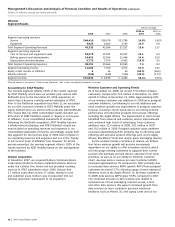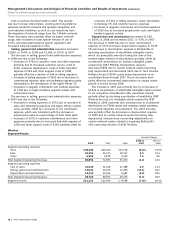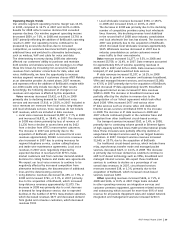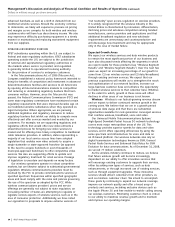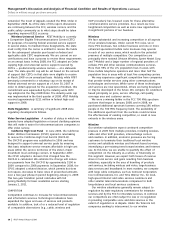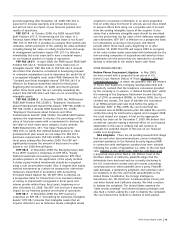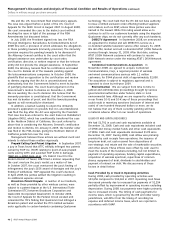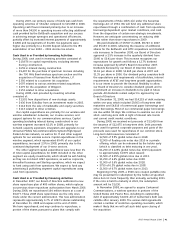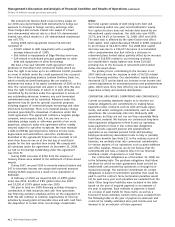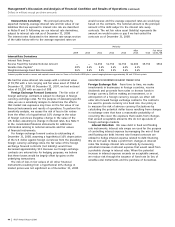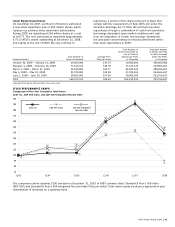AT&T Wireless 2008 Annual Report Download - page 37
Download and view the complete annual report
Please find page 37 of the 2008 AT&T Wireless annual report below. You can navigate through the pages in the report by either clicking on the pages listed below, or by using the keyword search tool below to find specific information within the annual report.
AT&T Annual Report 2008
| 35
U-verse Services We are continuing to expand our
deployment of U-verse high-speed broadband and TV services.
As of December 31, 2008, we have passed approximately
17million living units (constructed housing units as well as
platted housing lots) and are marketing the services to
almost 65 percent of those units. Our deployment strategy is
to enter each new area on a limited basis in order to ensure
that all operating and back-office systems are functioning
successfully and then expand within each as we continue to
monitor these systems. In these expansions, we expect to
continue to use contracted outside labor in addition to our
employees as installers; our rate of expansion will be slowed
if we cannot hire and train an adequate number of qualified
contractors and technicians to keep pace with customer
demand or if we cannot obtain all required local building
permits in a timely fashion. We also continue to work with
our vendors on improving, in a timely manner, the requisite
hardware and software technology. Our deployment plans
could be delayed if we do not receive required equipment
and software on schedule.
We believe that our U-verse TV service is subject to
federal oversight as a “video service” under the Federal
Communications Act. However, some cable providers and
municipalities have claimed that certain IP services should
be treated as a traditional cable service and therefore
subject to the applicable state and local cable regulation.
Certain municipalities have delayed our request or have
refused us permission to use our existing right-of-ways to
deploy or activate our U-verse-related services and products,
resulting in litigation. Pending negotiations and current or
threatened litigation involving municipalities could delay our
deployment plans in those areas. In July 2008, the U.S.
District Court for Connecticut affirmed its October 2007
ruling that AT&T’s U-verse TV service is a cable service in
Connecticut. We have appealed that decision on the basis
that state legislation rendered the case moot. If courts having
jurisdiction where we have significant deployments of our
U-verse services were to decide that federal, state and/or
local cable regulation were applicable to our U-verse
services, it could have a material adverse effect on the
cost, timing and extent of our deployment plans.
REGULATO R Y D E V E LOPMENTS
Set forth below is a summary of the most significant
developments in our regulatory environment during 2008.
While these issues, for the most part, apply only to certain
subsidiaries in our wireline segment, the words “we,” “AT&T”
and “our” are used to simplify the discussion. The following
discussions are intended as a condensed summary of the
issues rather than as a precise legal description of all of
these specific issues.
International Regulation Our subsidiaries operating outside
the U.S. are subject to the jurisdiction of regulatory authorities
in the market where service is provided. Our licensing,
compliance and advocacy initiatives in foreign countries
primarily enable the provision of enterprise
(i.e., large business) services. AT&T is engaged in multiple
efforts with foreign regulators to open markets to competition,
reduce network costs and increase our scope of fully
authorized network services and products.
Federal Regulation A summary of significant 2008
Federal regulatory developments follows.
Wireless
Wireless Spectrum Auction In March 2008, the FCC
announced that we were the winning bidder of 227 B Block
700 MHz Band wireless spectrum licenses in an auction
conducted by the FCC. Accordingly, in April 2008, we paid the
FCC $6,136, which was in addition to the $500 deposit that
we provided to the FCC at the start of the auction. This
purchase was funded using cash from operations and debt.
In April 2008, we submitted our license application to the
FCC, requesting that the FCC grant the wireless licenses on
which we were the high bidder. The FCC granted the licenses
on January 6, 2009. We will use this spectrum as we build
out our network for next generation wireless services.
Order on Recommendations of the Hurricane Katrina
Panel In October 2007, the FCC issued an order that was
intended to improve the reliability, interoperability and
recovery of telecommunications in future disasters. The order
required carriers to maintain backup power at certain points
in the network, such as cell sites and remote terminals.
In February 2008, the D.C. Circuit granted a stay of the
effective date of the Katrina Order’s backup power rules,
pending review of a filed appeal. In November 2008, the
FCC asked the court to dismiss the appeal as moot and
further indicated that it would begin a new rulemaking
proceeding to establish revised backup power rules.
To date, the court has not acted on the FCC’s request.
E911 Order In September 2007, the FCC adopted
an order (the E911 Order) that would have substantially
increased accuracy requirements in connection with providing
the location of a wireless caller to dispatchers of 911
emergency services. Compliance with interim accuracy
benchmarks would have been required in March 2009.
Under FCC rules, carriers are required to attempt to deliver
location data to Public Safety Answering Points (PSAPs) when
callers dial 911. We use a network-based location solution
that employs triangulation to estimate the location of the
caller. Location data for this network-based solution must be
accurate within 300 meters on 95 percent of all calls and
within 100 meters on 67 percent of all calls. The current rules
permit these percentages to be calculated based on all calls,
network-wide, for purposes of measuring location accuracy.
The E911 Order would have required wireless carriers to
achieve E911 location accuracy measured in each of the
local areas served by the approximately 6,000 PSAPs across
the country. Carriers would have had until September 2012
to achieve PSAP-level accuracy, and would have had to
demonstrate compliance with certain incremental location
accuracy benchmarks in 2009 and 2010. The PSAP-level
accuracy requirement in the E911 Order was not attainable
throughout our wireless network using currently available
commercial technology.
In March 2008, the United States Court of Appeals for
the D.C. Circuit (Court of Appeals) granted motions filed by
AT&T and other carriers seeking a stay of the E911 Order
pending a ruling on the merits of the appeals of that order.
Subsequently, the FCC filed a motion with the Court of
Appeals asking that the E911 Order be vacated and



